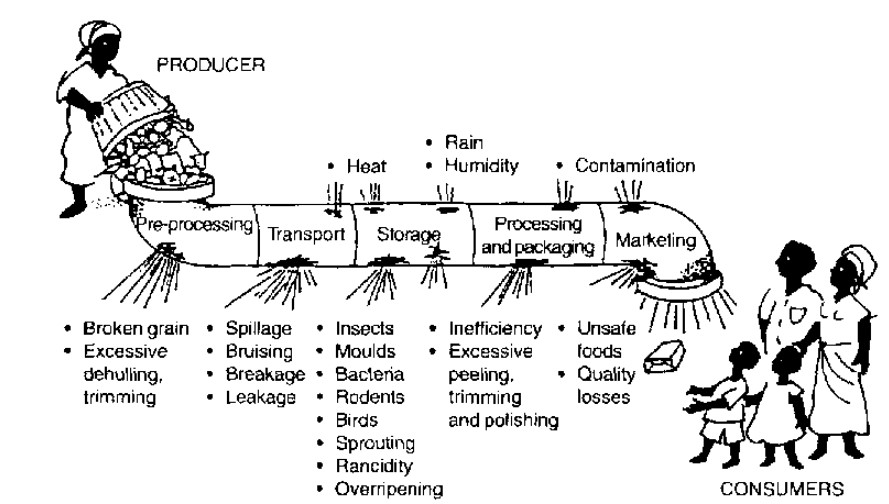- Courses
- GS Full Course 1 Year
- GS Full Course 2 Year
- GS Full Course 3 Year
- GS Full Course Till Selection
- Answer Alpha: Mains 2025 Mentorship
- MEP (Mains Enrichment Programme) Data, Facts
- Essay Target – 150+ Marks
- Online Program
- GS Recorded Course
- NCERT- First Ladder
- Polity
- Geography
- Economy
- Ancient, Medieval and Art & Culture AMAC
- Modern India, Post Independence & World History
- Environment
- Governance
- Science & Technology
- International Relations and Internal Security
- Disaster Management
- Ethics
- Current Affairs
- Indian Society and Social Issue
- CSAT
- 5 LAYERED ARJUNA Mentorship
- Public Administration Optional
- ABOUT US
- OUR TOPPERS
- TEST SERIES
- FREE STUDY MATERIAL
- VIDEOS
- CONTACT US
Storage, transport and marketing of agricultural produce in India
Storage, transport and marketing of agricultural produce in India
10-03-2023

Storage, transport and marketing of agricultural produce in India
Storage Of Agricultural Produce in India
- Storage of agricultural produce is the process of preserving harvested crops and livestock products for later consumption or sale. Proper storage helps to prevent spoilage, reduce post-harvest losses, and ensure food security.
- There are several methods of storing agricultural produce, and the choice of storage method depends on factors such as the type of produce, climate conditions, and storage period.
Forms of Storages of agricultural produce
- Warehouses: India has a network of public and private warehouses for storing agricultural produce. The Food Corporation of India (FCI) and the Central Warehousing Corporation (CWC) are two major government agencies that provide warehousing facilities across the country.
- Cold Storage: India has a large number of cold storage facilities for preserving perishable produce such as fruits, vegetables, and dairy products. The National Horticulture Board provides subsidies to encourage the construction of new cold storage facilities.
- Traditional Storage: In rural areas, traditional methods such as grain storage in mud houses, underground pits, or bamboo baskets are still used. These methods are low-cost and effective for storing grains and pulses.
- Grain Silos: Grain silos are used for storing grains such as wheat, rice, and corn. The government has set up the Food Corporation of India Silos Project to build modern silos with automated systems for monitoring and controlling storage conditions.
- Controlled Atmosphere Storage: This method involves storing produce in a controlled atmosphere with temperature, humidity, and oxygen levels carefully controlled. This method is commonly used for apples, pears, and other fruits.
- Food Parks: The government has set up food parks across the country to provide infrastructure facilities for food processing and storage. These parks have facilities for cold storage, warehousing, and food processing, and are designed to reduce post-harvest losses and improve the value chain of agricultural produce.
- Storage with cover: FCI, CWC, and SWCs all use this storage method the most. The grain storage method involves the use of a jute bag. Jute-bagged grains are stacked in godowns or warehouses.
- The Cover and Plinth (CAP) Method involves storing food grains openly with necessary safeguards like rat- and damp-proof plinths. Dunnage and covering stacks with special polythene covers, among other things, are also used in this method.
- Silos: Grain is stored in these tall tower-like structures. Silos are more efficient because they can operate around the clock and require 30% less land than traditional warehouses.
- Method of the silo bag: Silo-bags are a type of hermetic storage made from a plastic tube-shaped bag. The grains can be shielded from rain, UV rays, humidity, dust, etc., by these bags. Additionally, they are best suited for assisting with harvest logistics for short-term, high-volume grains.
What difficulties do food grain storage in India present?
- Lack of adequate storage facilities: At the farm level, India currently lacks the necessary storage facilities, resulting in grain pest and insect damage. Additionally, the country's storage facilities are not suitable for the long-term storage of grains.
- India's storage capacity imbalance: In 2013, a CAG report revealed a significant imbalance in storage capacity availability. It was discovered that storage facilities in consuming states lacked a significant amount of space. According to the report, 64% of the FCI's total storage space was in large procurement states like Punjab, Haryana, Andhra Pradesh, Uttar Pradesh, and Chattisgarh.
- Infrastructure of subpar quality: The necessary conditions, such as the right temperature and moisture, are not present in the godowns or warehouses. This seriously deteriorates the grain quality, resulting in stock damage and waste. Because there are no secure storage facilities, the grains are infested with molds and insects. In light of this, the CAG report from 2013 noted that food grains in the central pools managed by State Government Agencies in Punjab and Haryana were severely damaged due to inadequate safe and scientific storage practices.
- Space-saving storage: During the procurement seasons, there were no adequate Cover and Plinth storage facilities, so stocks were simply deposited in open spaces without any safeguards to preserve these excessive grains. Because there isn't enough plinth, water seeps from the ground and causes flooding and rain, causing damage to the stocks.
Potential consequences of poor storage of agricultural produce in India:
- Economic Losses: Poor storage can lead to spoilage, pest infestations, and quality degradation, all of which can result in significant economic losses for farmers and traders. These losses can be particularly devastating for small-scale farmers who may not have the resources to invest in proper storage infrastructure.
- Food Insecurity: Poor storage can lead to post-harvest losses, which can contribute to food insecurity and malnutrition. India already faces challenges related to food security, and poor storage practices can exacerbate these challenges by reducing the amount of food available for consumption.
- Health Risks: Poor storage can lead to the growth of harmful bacteria and fungi, which can cause illness or even death if consumed by humans. This is particularly a concern for perishable crops like fruits and vegetables that are often consumed raw.
- Reduced Access to Markets: Poor storage can limit the ability of farmers to sell their crops in distant markets, as the crops may not be able to withstand the transportation and storage requirements. This can limit the opportunities for farmers to sell their crops and generate income.
- Environmental Impact: Poor storage can also have environmental consequences, such as increased greenhouse gas emissions due to the need to transport and store crops for longer periods. Additionally, when crops are not stored properly, they may be discarded or left to rot, which can contribute to landfills and other waste management challenges.
Way forward: Shanta Kumar Committee recommendations
- Farmers can use the Negotiable Warehouse Receipt system to deposit their produce in registered warehouses and receive a roughly 80 percent advance from banks against their MSP-valued produce. When prices are profitable, these farmers can sell later.
- The private sector will be reestablished under this system, the government will save money on storage, and a market economy will be more compatible with it.
- The Committee suggested that FCI outsource its stocking operations to other organizations like the Central Warehousing Corporation, the State Warehousing Corporation, the private sector through the Private Entrepreneur Guarantee (PEG) scheme, and even state governments like Madhya Pradesh, which are using the private sector to construct silos on state lands.
- In order to eliminate grain stocks that last longer than three months, covered and plinth (CAP) storage should be phased out gradually. CAP must be replaced by silo bag technology and conventional storage methods.
TRANSPORTATION OF AGRICULTURAL PRODUCE
- Transportation of agricultural products is an essential aspect of the agriculture industry.
- It involves the movement of goods from farms, ranches, or other agricultural operations to processing facilities, markets, and consumers.
Importance of transportation of agri-produce
- Transport is crucial because it makes agriculture easier, encourages farmers to spend more, and boosts output.
- Additionally, a significant amount of the labor-intensively produced goods would be wasted without this transportation mechanism.
- On the other hand, the farmer may maximize his or her profits if there is an efficient transportation infrastructure and agricultural produce is handled with care.
- Nonetheless, unit prices may remain low and the agriculture value chain robust with an efficient transportation and marketing system.
- Keeping transportation costs low makes it accessible to consumers and helps farmers make a profit.
- On the other hand, compared to nations with more efficient transportation, agricultural export potential and local marketing would be diminished if transportation costs are high.
- Transport opens up new economic focus areas, improves contact between geographical and economic regions, and creates a market for agricultural products.
- There will be less output, less income, and a lower standard of living in rural areas with poor transportation.
Challenges faced in the transportation of agricultural products include:
- Poor road infrastructure: Poor-road conditions, inadequate road networks, and inadequate maintenance of existing roads can cause delays in the transportation of agricultural products, leading to spoilage, loss of quality, and reduced profits.
- Inadequate storage and packaging facilities: Proper storage and packaging of agricultural products are essential to maintain their quality during transportation. Inadequate storage and packaging facilities can cause damage to products, leading to spoilage and loss of value.
- Inefficient logistics systems: Inefficient logistics systems can cause delays in the transportation of agricultural products, leading to spoilage and reduced quality.
- Lack of proper temperature control: Some agricultural products require proper temperature control during transportation to maintain their quality. Lack of proper temperature control can lead to spoilage and reduced quality.
- Seasonal variations: Agricultural production is seasonal, and the transportation of agricultural products may be affected by seasonal variations, leading to fluctuating demand and supply, and affecting prices.
- Government regulations: Government regulations, such as import/export restrictions, taxes, and tariffs, can affect the transportation of agricultural products, leading to increased costs and reduced profitability.
- Security concerns: Transportation of agricultural products may be affected by security concerns such as theft, vandalism, and attacks on transportation vehicles, leading to loss of products and reduced profitability.
Reforms needed in transportation of agricultural products in India include:
- Improving road infrastructure: India needs to invest in improving road infrastructure, including building new roads, repairing existing ones, and ensuring proper maintenance of roads. This will help reduce transportation time and costs, leading to improved profitability for farmers.
- Enhancing storage and packaging facilities: India needs to invest in enhancing storage and packaging facilities to reduce spoilage and maintain product quality during transportation.
- Implementing efficient logistics systems: India needs to implement efficient logistics systems that can help reduce transportation time, improve efficiency, and reduce transportation costs.
- Encouraging public-private partnerships: The government should encourage public-private partnerships to invest in transportation infrastructure, storage facilities, and logistics systems, to improve the efficiency and profitability of the sector.
- Streamlining government regulations: The government needs to streamline regulations related to transportation of agricultural products, including import/export restrictions, taxes, and tariffs, to reduce transportation costs and increase profitability.
- Providing financial support: The government needs to provide financial support to farmers and transporters to invest in transportation infrastructure, storage facilities, and logistics systems.
- Promoting alternative modes of transportation: India needs to promote alternative modes of transportation, such as water transport and railways, to reduce transportation costs and improve efficiency.
Steps Taken
- Launch of Kisan rails: Kisan rails are the first multi-commodity trains in the world. The quick delivery of perishable agricultural goods to markets like fruits and vegetables will be made easier with the help of these trains with chilled carriages. These will guarantee the transportation of agricultural goods across the nation.
- Krishi Udan scheme: Value realization (on agricultural goods) would significantly rise as a result, particularly in tribal territories and the north-east.
- Assistance with Transport and Marketing (TMA): It aims to assist with the international freight and agricultural product marketing aspects.
- This is likely to promote brand recognition for Indian agricultural products in the specified overseas markets and to mitigate the disadvantage of the higher cost of transportation of certain agricultural products due to trans-shipment.
- Kisan Rath mobile application: will permit the transportation of foodgrains and perishables.



